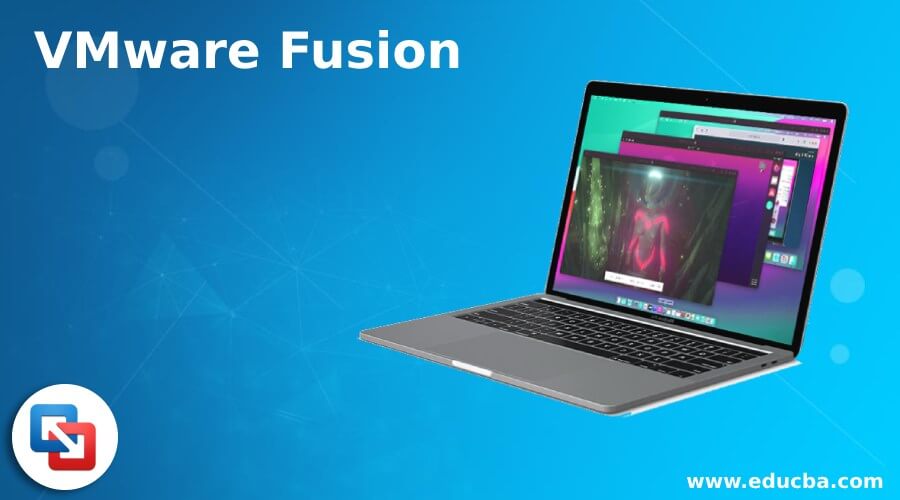Updated June 2, 2023

Introduction to VMware Fusion
VMware Fusion is originally developed for the MAC operating system or the Macintosh computers. The VMware Fusion is nothing but hypervisor software and was originally developed by VMware. Generally, the VMware Fusion is allowed to create a virtual machine based on the Intel-based MAC. Here, the host operating system is the MAC operating system, and we can run the different guest operating systems like NetWare, Solaris, Microsoft Windows, Linux, MAC OS, etc.
The VMware Fusion it is using a different concept for the Mac transition. It majorly uses the two concepts first is paravirtualization, and the second is hardware virtualization. With the help of paravirtualization and hardware virtualization combination, we can successfully transition the Mac into the Intel processors. This was achieved in 2006.
How does VMware Fusion Work?
The VMware fusion works on the Intel base MAC operating system. With the help of paravirtualization and hardware virtualization, we can create virtual machines on top of the MAC operating system. Once the actual or the existing hardware is virtualized. We can create our favorite operating systems like Linux, Windows, etc. We can define the virtual machine with the virtual resources, disk, RAM, CPU, network, etc.
Below is the list of the system requirements for the VMware Fusion:
- We need any MAC operating system with an Intel-based processor. The min requirement of the Intel processor is 1.5 GHz. We can also consider the faster processor.
- We need min 512MB of RAM or 1GB. It is the recommended value. It is very less requirement. We need more RAM to run the virtual machine on the MAC Operating system.
- We need free disk space of min 275MB for the VMware Fusion. We need at least 1GB of free disk space for each virtual machine.
- If we need to work with the VMware Fusion, we must list the 10.4.9 version of the MAC operating system. If we get it higher than that, it will also work.
Advantages and Disadvantages of VMware Fusion
Given below are the advantages and disadvantages mentioned:
Advantages:
- It will use fewer resources, i.e., the OSX flies. Due to the paravirtualization technique, it will bring the OSX to a crawl in seconds (at the time).
- It will utilize the resources of 2% CPU inside the VM. The parallel Pause process or the function will utilize the 9 to 10%.
- It can hibernate a VM, whereas in parallel, every time you want to quit the program, you need to shut down Windows completely. (Talking about Boot camp VMs)
- It has a faster CPU process, less memory utilization, and a better I/O option.
- It will not corrupt Windows operating system virtual machine. (But in the older versions having the VM crashing problems)
- In the Cocoa app, it will able to keep less memory utilization in the Windows Server.
- The starts and stops process is much faster as compared to the parallels.
- It will provide better USB 2 support. It will also provide good support to the different devices like the WM phones and stuff.
- We are getting excellent support from the VMware engineers. Even though we have a good community platform to get help on any issues.
- The stability of the product is good. It will not crash down. If we consider the parallel crashes, it will be at least one of the days.
Disadvantages:
- It will need a much strong hardware platform. But the small infrastructure works slowly, like the Core – 2Duo Macbook Pro, 2GB RAM, 10.4.9 version, and 2 CPUs.
- If we work with the 2D graphics, it will utilize 40% to 50% of Parallels. It will depend on the action.
- The command + H option will not work if we work in full-screen mode. Once it hides, it will not return to the screen window. Until we can’t click on the MAC tray or until we can right-click on the dock icon.
- It is having some network-related issues. Majorly it is giving some issues with the ADSL type of the network connection.
- It is giving some issues while we are connecting with the working environment or the will connect with the specific Domain. Generally, it will not open at the initial stage after retries 2 to 3 times, then it will connect.
- The drag-and-drop option is not working while we are working with the guest and host. In some cases, it will print the error messages also.
- It will not use the separate hardware profile for the virtual machines. Hence it will lead the Device Manager in a “Multiprocessor ACPI PC.”
Uses of VMware Fusion
Given below are the uses mentioned:
- We can use the VMware Fusion to run the Windows and Linux applications on an Intel-based MAC operating system.
- While protecting the integrity of the Mac, We can run multiple or different operating systems.
- VMware Fusion will safely run the virtual machines. It will isolate from the host MAC operating system. It will consider the hardware security and fault isolation of the virtualization.
Features of VMware Fusion
- Screen sharing
- File transfer
- Smart card authentication
- Access to sleeping/powered-off computers
- Remote session over the Internet
- Remote control from mobile
- Multi-platform remote control
- Session record
- Annotations
- Monitoring and alerts
- Multiple platforms remote control
Conclusion
We have seen the uncut concept of VMware fusion with the different features and options. The VMware Fusion is designed to create the guest virtual machine on top of the MAC operating system. But while doing this, we ensure it is based on the Intel processor. We can deploy multiple or different operating systems and run them parallelly.
Recommended Articles
This is a guide to VMware Fusion. Here we discuss the introduction, working, advantages & disadvantages, uses, and features. You may also have a look at the following articles to learn more –
